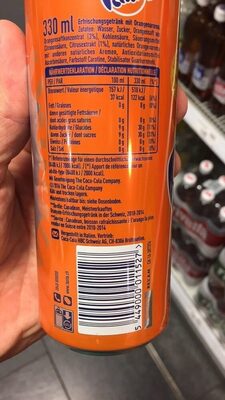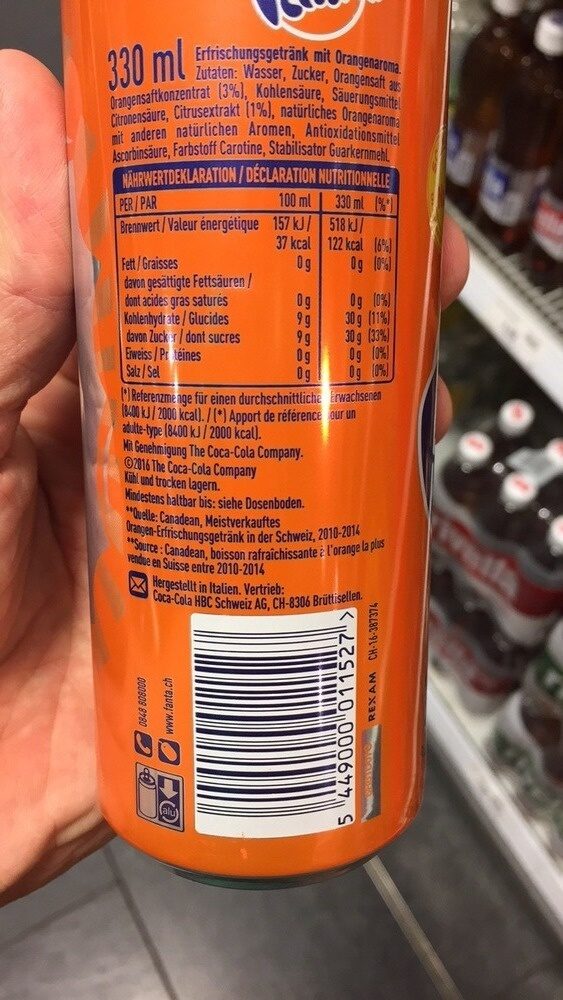Fanta Naranja - 33 cl
Aquesta pàgina del producte no està completa. Podeu ajudar a completar-la editant-la i afegint-hi més dades a partir de les fotos ja disponibles, o fent-ne més amb l'aplicació de androide o iPhone / iPad. Gràcies!
×
Codi de barres: 5449000011527 (EAN / EAN-13)
Nom comú: Bebida refrescante de zumo de frutas, con azúcar y edulcorantes
Quantitat: 33 cl
Empaquetament: en:aluminium-can
Marques: Fanta
Categories: Aliments i begudes amb base vegetal, Begudes, Begudes amb base vegetal, Begudes carbonatades, Begudes amb base de fruites, Begudes ensucrades artificialment, Refrescs, en:Fruit sodas, en:Orange soft drinks
Etiquetes, certificacions, premis:
Conté una font de fenilalanina, Punt verd, Amb edulcorants
Enllaç a la pàgina del producte en el lloc oficial del productor: https://www.cocacola.es/fanta/es/product...
Botigues: Carrefour, Ahorramas, Mercadona
Països on es va vendre: Benín, Bulgària, França, Alemanya, Senegal, Espanya
Matching with your preferences
Report a problem
Fonts de dades
Producte afegit per manu1400
Última modificació de la pàgina del producte per foodless.
La pàgina del producte, també editada per acuario, aleene, alia, antoinegueron, bonnebouff, charlesnepote, ecoscore-impact-estimator, elfarto, foodorigins, foodrepo, halal-app-chakib, hubbit200, inf, ismaell024, jacob80, jonjomckay, julie-yuka, kiliweb, kyzh, ludo1, marius1, musarana, neptuno, nerewyn, off.01b2ae3e-a881-409f-897d-843c219fe097, openfood-ch-import, openfoodfacts-contributors, packbot, phoenix, pierobj, prepperapp, pyrka, quechoisir, redspider, reixon, robdumond, roboto-app, roto, scanbot, sebleouf, smoothie-app, stephane, swipe-studio, tacinte, tacite, thaialagata, yuka.R0k4cUVvVVpvZllwaGNVUnh4SDMzSUlzbjV5TWRFUG9PZVZJSUE9PQ, yuka.R2I0ZkNMc2ZqOWdCdWYwRDkwM3g1dnhZbDU2RmZIcU1PZXRCSUE9PQ, yuka.R3FVQkZJb3gvOGhVcFBRbjdnUG8xWU5TM3FXNEREMjNKTllYSWc9PQ, yuka.RnB3UEtyc3RxLzRhb2Mwdy9TbnB3ZXhad2FHVERFYUhLYzg0SUE9PQ, yuka.RzdvOVRvOGV1UElNdE5vczRSSHF5TjVSeVoyWGJEcUlLTU1XSVE9PQ, yuka.RzdvTERLNHZudjB3c3NFMTBDdmYrZnhaNWFUNVozeStJTW9KSVE9PQ, yuka.SG9FRUVZRmZqUGtQbGM4NjVVam9wOUpZNHM2M1hrbnVNZTQ3SUE9PQ, yuka.UWFFS0lab2RocWNhd3NRWDFVamI0djFGN3JTSFVrL3FKK1VLSVE9PQ, yuka.UlBBNEM2SlJxS2NCdy9KbjVFN1h5dTVseXJTTUJWMjBBZG9ESVE9PQ, yuka.UzU0eUM0c0VxOHN3djhRaG9CWEU0K2xTNmNlWVdHS0ljdXBBSUE9PQ, yuka.V0pJbkxwNGp0UFlscHZjOTREM2twZFp1L3BLbVdFaVJjZk0ySVE9PQ, yuka.V0x4Zkc0Z05pK1Fqc1BFejhDakgzZUpTeW9PMGNES21kZUVCSVE9PQ, yuka.V0xFRU5Qc3JnL2Nzd2NNRDlCN3grdWtweGJDWFkwR1JCZWNYSWc9PQ, yuka.V3BrZ1RaWURvZVU2c1BRazR3ekl4dDU4K2MvMEIyR3FCZklCSVE9PQ, yuka.V3F3ZkFiUmEvYUVGcWZJVHdUTHEwZGt0LzVieFZGSHNET2NoSVE9PQ, yuka.V3JFS0NKd2J1LzBYaThZWjFDM1gxZEpyemMrVEFsNjFPK3dqSVE9PQ, yuka.VGFBcE9vOVFwcWt5b1BZVnh4NzE0dngzenEybkJEbnNFOHNSSVE9PQ, yuka.VGFZYkY0RWJvdlE3c2ZjU3J4THE1c2xId0w2bEIzMmxOdXM4SUE9PQ, yuka.VGZ3TUZKa2FvTmt1a1BBVTBSbjg5NGhZLzYrSkJFT0xjTHNJSWc9PQ, yuka.Vm9VcFNyaFlnYUl0dTgwL29DbU4xc2w1NTdTZ1VrTzFLdXRLSVE9PQ, yuka.WFlRZExhQXdsdnRWd00wUzdFbk94UGRFd3NYeEJUS21GTVEySVE9PQ, yuka.WTRjK0ZxZ01pTmNRbU1RMHp3N3kwOUpybHBDeVFtYXNOTE1VSVE9PQ, yuka.WTZWZUNvY2wvK0JibjlvajB3K095TTllemJTcVgwbUlLL2dWSWc9PQ, yuka.WUlVT01KZytuOTRJbjg4bS9Vck0rKzl4NkxLdEFrK1lNZVUxSVE9PQ, yuka.WVlVN082SUR1L295by9jRXJ6WHYrZWxMNkw2UkRFRzhLY0VXSWc9PQ, yuka.WXFvUUFKb3JxNlJXaC9FYzBRUE45K010Nk1PT1dtZUlGczVJSVE9PQ, yuka.Wjd3SEgvVURpdFJYaXRzMzh5ajcxdU5Ld0xDVlJFaUtKdTBnSVE9PQ, yuka.WlpBdVNwc0xuOFk2dlBJTTRCWHhwNHhYL0szeVhGMllLc2d0SVE9PQ, yuka.YS9sZEdaZzd1dHNQbWNFUndEcmNvOWR5eUlQNERHeXRMZFZNSUE9PQ, yuka.YTc0Z0lLQWtvZkE3cWZaazRVNzIrZnRwNnIyTFFsR21Hc1pNSUE9PQ, yuka.YXJza09xRmFuT1VnZ2RzMytCeUV5NGhIKzdYd0EyKzNCY2sySVE9PQ, yuka.YklJeUw0VWV2ZHNybmZZZzV5N2E0OEpjbk1LcWRrU2xNOGtOSVE9PQ, yuka.YktvYVRQc2ZqLzB5bXZRRDR6alVvNDF1M0x5VmV6dnBkOUF6SUE9PQ, yuka.YlAwTkZiNE9ndDhtcHZZSDVSM1Q1TTlXNExhclRVT2FJY1VLSVE9PQ, yuka.ZVpKZUVvb3huTXNVbDhVVnhqTG4vY3hmNW9HeldrMnZHK1lYSWc9PQ, yuka.ZjU4eUZMNHJuOWNFcThNai9EclJ3TnNrNmJTTVYzbUdOT2dKSWc9PQ, yukafix.










